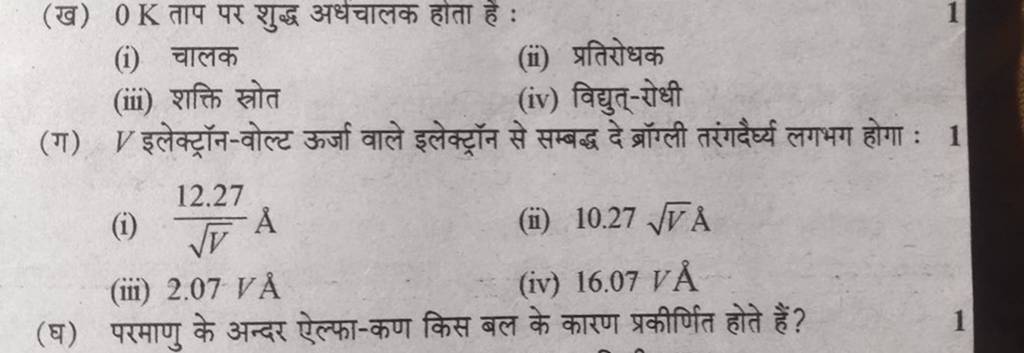Question
Question asked by Filo student
(ख) ताप पर शुद्ध अधंचालक होता है : (i) चालक (ii) प्रतिरोधक (iii) शक्ति स्रोत (iv) विद्युत्-रोधी (ग) इलेक्ट्रॉन-वोल्ट ऊर्जा वाले इलेक्ट्रॉन से सम्बद्ध दे ब्रॉग्ली तरंगदैर्घ्य लगभग होगा : 1 (i) (ii) (iii) (iv) (घ) परमाणु के अन्दर ऐल्फा-कण किस बल के कारण प्रकीर्णित होते हैं?

Found 5 tutors discussing this question
Discuss this question LIVE
5 mins ago

One destination to cover all your homework and assignment needs
Learn Practice Revision Succeed

Instant 1:1 help, 24x7
60, 000+ Expert tutors

Textbook solutions
Big idea maths, McGraw-Hill Education etc

Essay review
Get expert feedback on your essay

Schedule classes
High dosage tutoring from Dedicated 3 experts
Practice more questions on Electrostats
Question 1
Medium
Views: 5,831
Question 2
Medium
Views: 6,025
Thinking Process
This problem require an insight to magnetic field due to current carrying solenoid having varying current which induces emf in coil of radius .
Question 3
Easy
Views: 5,463
Question 4
Hard
Views: 5,402
(a)
(b)
(c)
(d)
Students who ask this question also asked
Question 1
Views: 5,540
Question 2
Views: 5,530
Question 3
Views: 5,267
Question 4
Views: 5,129


Stuck on the question or explanation?
Connect with our Physics tutors online and get step by step solution of this question.
231 students are taking LIVE classes
| Question Text | (ख) ताप पर शुद्ध अधंचालक होता है :
(i) चालक
(ii) प्रतिरोधक
(iii) शक्ति स्रोत
(iv) विद्युत्-रोधी
(ग) इलेक्ट्रॉन-वोल्ट ऊर्जा वाले इलेक्ट्रॉन से सम्बद्ध दे ब्रॉग्ली तरंगदैर्घ्य लगभग होगा : 1
(i)
(ii)
(iii)
(iv)
(घ) परमाणु के अन्दर ऐल्फा-कण किस बल के कारण प्रकीर्णित होते हैं? |
| Updated On | Jan 2, 2023 |
| Topic | Electrostats |
| Subject | Physics |
| Class | Class 12 |
| Answer Type | Video solution: 1 |
| Upvotes | 94 |
| Avg. Video Duration | 10 min |
